Lithium Coin-Cell Batteries: Predicting an Application Lifetime
|
Abstract: This application note discusses various contributors to battery capacity consumption in a battery-backed application, and how to predict battery lifetime in a system. A designer should be able to use this application note to determine the battery requirements for his system. Why Battery Backup?There are several alternatives for data retention while the system is powered-off. Battery-backed SRAMs are a reliable alternative when the read-write speed or number of cycles is important. Flash or EEPROM also provide NV data storage, but at the cost of simplicity or speed. The major disadvantage of battery-backed SRAM is that the battery is a consumable. Therefore, the product selection must consider the available charge within the battery to determine the end product's lifetime. For devices that need to maintain time in the absence of system power, some form of electrical energy needs to be available to maintain a crystal oscillator. This current demand is well suited to being maintained by a battery.IC Current DemandsIf an IC (SRAM or RTC) is going to be battery powered, there needs to be a match between the current demands of the IC, the expected lifetime, and the energy available in the battery. If the IC and battery are being purchased, the data sheet specifications will provide the information required to predict the lifetime of the battery as a function of the IC load. If the IC and battery are being purchased as a module, end users can rely on the module manufacturer to have the appropriate screens in place to ensure that the system lifetime meets the specification.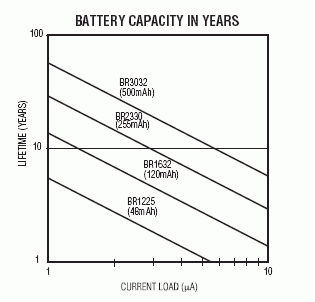 Figure 1. Lifetime based on amount of current being pulled from the battery. Maxim has established screening limits on all of its battery-backed products that allow the available battery capacity to power the end part for specified lifetimes up to 10 years. In the case of Maxim ICs, the design and fab processes have been optimized to produce low-current demands. In the case of higher density SRAMs purchased from outside vendors, special screening is sometimes required to ensure that the module lifetime specifications are met. Figure 1 is produced from battery capacities reported by Panasonic. The four lines shown in Figure 1 represent four of the most common battery sizes (BR1225, BR1632, BR2330, and BR3032). The battery manufacturers' rated electrical capacity (in mAh) is shown with each battery size. Battery Construction/AttributesMaxim has chosen to use primary lithium coin-cell batteries in modules that require battery backup. These cells, which have a rated voltage of 3V and a typical in-system voltage around 2.7V, make them well suited as a backup supply. The voltage also remains stable during the battery discharge (Figure 2), so the voltage at the end of life is nearly the same as with a fresh battery. While a flat discharge curve is desirable for backup supply voltage, it does make predicting the remaining electrical capacity difficult.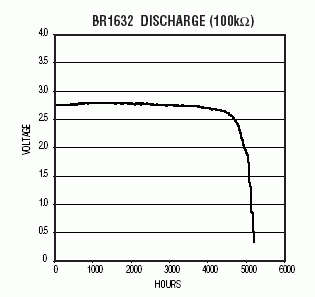 Figure 2. The output voltage remains constant during discharge. Primary lithium coin-cell batteries have a very predictable behavior. Distributions of such key parameters as open-circuit voltage or internal impedance are very tightly grouped. These tight distributions allow the battery manufacturers to set aggressive test limits in their process to ensure that abnormal cells are excluded from the population. These tight distributions also allow the user of the batteries to identify IC/battery systems that contain a defect. For example, since the voltage distribution and the voltage vs. battery load is very predictable, the battery voltage after a load has been attached can be an indicator of the load placed on the battery. If the battery load is the current demand of a well-behaved distribution of ICs, the resulting loaded voltages will also be tightly distributed. Any loaded voltage that is seen outside of the normal distribution is then an indication of an abnormal IC or battery. This result can be used to reject the resulting module as a potential reliability risk. Battery Testing/ScreeningThe battery manufacturer's 100% testing creates an extremely consistent product. However, anyone using batteries as an integral part of his system should employ testing methods to ensure that only properly functioning cells are included in the end product. There are three types of defects that can be detected by a properly defined screen. First are the test escapes from the battery manufacturers' system. These are the easiest to detect. The second form of defect is low-level internal leakage. It is possible for a battery to have an internal defect that would manifest itself only after some period of time. Detecting these cells requires a thorough understanding not only of the proper testing levels but also the anticipated distribution of results. The third type of defect is a handling or manufacturing defect by the battery user. Because of the limited amount of electrical capacity available, inadvertent loads placed on the cell for even short periods of time can result in reduced electrical lifetimes.A thorough screening program will involve 100% tests for electrical characteristics at key steps in the manufacturing process. Because of the predictable nature of the electrical performance, measuring the battery voltage before and after load-attach will identify cells that are abnormal. Such screening also will identify loads that are not typical. In addition to the electrical screening, a visual sampling of the batteries will help identify manufacturing variations that could result in degraded leak resistance. Battery Reliability ModelThe battery is a "balanced construction" with the reactive components included in quantities that should result in full reaction. The key components to the electrical reaction are the metallic lithium, cathode, and electrolyte. The battery manufacturers' goal is to maximize the available energy placed in the cell. Since the internal volume of the battery is limited, the maximum energy density is achieved when the components are in exactly the correct ratios. Therefore, any component loss limits the available reaction of the other components. The reliability model for batteries takes the balanced construction into account and seeks to determine what will cause any key component depletion.Because the battery is a consumable in the system, the most obvious limitation of the lifetime will be an electrical load placed on the battery. The lifetime based on an electrical load is easy to calculate. Simply divide the available battery capacity in milliamp hours by the current demand in milliamps to get the lifetime in hours. Determining the battery's lifetime as a function of electrical load also requires consideration of the power-on duty cycle. In a properly designed system, the battery is electrically isolated while system power is applied. This eliminates any battery current draining or charging. The reduced duty cycle will effectively extend the lifetime of the battery in systems that are powered up a high percentage of the time and are relying on battery backup for only a short time. Because these batteries are being used in very low or zero-current applications, users also need to look for other possible mechanisms that will deplete any of the reactive components. One such mechanism is electrolyte loss through the crimp seal. This mechanism has been shown to be temperature-accelerated with an activation energy of approximately 1.0eV. At room temperature the batteries will exhibit an electrical loss rate of less than 0.5% per year, and this mechanism can safely be ignored. However, at elevated temperatures the loss rate of the electrolyte can become significant and must be considered. Because of the reactive components' balanced nature, it does not matter whether the electrical reaction consumes the electrolyte or it is expelled through the seal because of elevated temperatures. When the battery does not have enough electrolyte to continue the reaction, the battery will no longer provide current. Therefore, we recommend using a parallel model for lifetime predictions that considers the electrical demand and temperature when predicting the system lifetime (Figure 3). There are models that treat the electrical and temperature depletion legs as independent and predict a lifetime as if there were no interaction between the two components of electrolyte loss. Using such a model will overstate the true lifetime if the system is exposed to temperatures much higher than room temperature. Calculating the lifetime of the battery is similar in concept to calculating the effective resistance of two parallel resistors. The user has control over whether the IC is consuming power from the battery or the system's power supply, so the current consumption leg is shown to include a switch. While the IC is being powered from the system power supply, the lifetime due to current consumption can be approximated as infinite. The manufacturer of the IC/battery system has control over the selected components and manufacturing process. Properly selected components and manufacturing screens should result in adequate system-level lifetime. However, end users have control over the ultimate lifetime performance based on the actual use of the system. End users can control both legs of the model. The electrical load leg is controlled through the power-on duty cycle of the equipment. While system power is applied, the Maxim components include battery isolation circuitry that electrically isolates the battery and eliminates all current drain from the battery. Therefore, the electrical load leg of the reliability model is only active while the system is in battery backup. The system ambient temperature controls the temperatureaccelerated leg. Providing adequate cooling and proper component placement can help reduce the temperature exposure of the battery and, thereby, extend the system's lifetime. 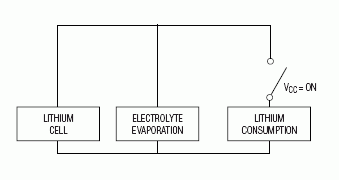 Figure 3. Battery lifetime based on electrolyte evaporation and electrical consumption. 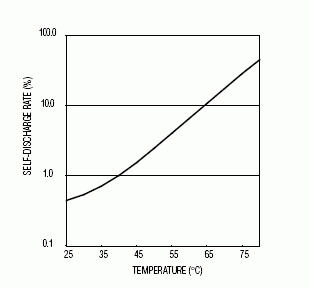 Figure 4. The self-discharge rate increases as temperature increases. Sample Lifetime CalculationsCase I—The system is designed to be in battery backup 100% of the time at room temperature. The electrolyte evaporation at room temperature is so low that it can virtually be ignored. The lifetime is limited by the IC's current drain.Electrical Consumption Leg ?Battery capacity (BR1632) = 120mAh ?IC current drain = 1.2μA ?Duty cycle = 100% ?Battery lifetime = (0.12Ah) / (1.2 × 10-6A) = 100,000 hours = 11.4 years Electrolyte Evaporation Leg ?Battery lifetime at +25°C = 230 years ?Calculation : (230 × 11.4) / (230 + 11.4) = 10.9 years Case II—The system is designed to be in battery backup 50% of the time at +60°C. The lifetime due to either the electrical consumption or electrolyte evaporation would appear to be approximately 20 years. The combination of the two mechanisms will cause the electrolyte to be consumed in 10 years. Electrical Consumption Leg ?Battery capacity (BR1632) = 120mAh ?IC current drain = 1.2μA ?Battery lifetime = (0.12Ah) / (1.2 x 10-6A x 50%) = 200,000 hours = 22.8 years Electrolyte Evaporation Leg ?Battery lifetime at +60°C = 19.1 years ?Calculation: (19.1 x 22.8) / (19.1 + 22.8) = 10.4 years Integrated Battery ControllersIf a system is to contain battery-backed SRAM or RTC, it is important to use an appropriate battery controller. These controllers handle the switching from system power supply to the battery in the event of power failure. They also provide the on-chip reverse-charging protection required by Underwriters Laboratory or other testing agencies. Maxim sells standalone battery controllers that allow the system designer to customize a system based on battery-capacity demands or layout constraints.While the standalone battery controllers are well suited for certain applications, their use comes with some additional costs. Not only must end users select and acquire an appropriate battery, but the manufacturing process must also accommodate the particular battery requirements. Because of the limited available capacity in a battery, the manufacturing process must ensure that no inadvertent loads are placed on the battery. This requires that the batteries be handled with insulated or nonconductive tools while many other components in the design are ESD sensitive and should be handled with conductive tools. The materials used in lithium battery construction limit their temperature exposure capabilities. A single pass through a reflow solder operation destroys the battery, which raises the question of whether the battery should be attached to the PCB with a mechanical holder or soldered to the PCB. A mechanical holder can be attached to the PCB using automated equipment and reflow solder. The battery is then inserted after the hightemperature processing is complete. The mechanical holder eliminates any temperature exposure to the battery, but the resulting system depends on the mechanical contacts holding the battery in place. Attaching the battery to the PCB with solder requires purchasing a tabbed battery and hand soldering that component after all reflow solder operations have been completed. A final concern with using a battery controller and separate battery is the cleanliness of the manufacturing process. Even trace amounts of ionic contaminants can result in electrical leakage paths that can place loads on the batteries equal to the designed IC load. This will greatly shorten the system's effective life. Battery Module ProductsUsing a module product that contains the battery controller and battery will avoid some of the problems discussed above. The module manufacturer will have the required processes to handle the batteries without degradation, and the module construction will also help isolate the battery from the end user's environment, thereby avoiding some of the ionic contamination issues. The end result can maximize battery lifetime.In addition, many of the Maxim modules incorporate a "Sleep Mode" function that isolates the battery until system power is first applied. This feature allows the module products to be assembled and fully tested; the electrical load is then removed from the battery. Thus, the parts can be left in inventory for an extended period without removing any charge from the battery. ConclusionMaxim's battery-backup products are designed and manufactured to provide end users with a specified lifetime. This lifetime has been calculated under "worst case" conditions and assumes that the part will be in battery-backup 100% of the time. By understanding the mechanisms involved in the depletion of the battery, end users can reasonably and accurately predict system lifetimes based on the power-on duty cycle and the battery temperature exposure.If users decide to select one of the battery controllers sold by Maxim and provide their own battery in the system, they should consider the battery's nature in the selection process. Proper IC screening and battery testing are required to ensure the available capacity is adequate to provide the desired lifetime. |
 電子發燒友App
電子發燒友App










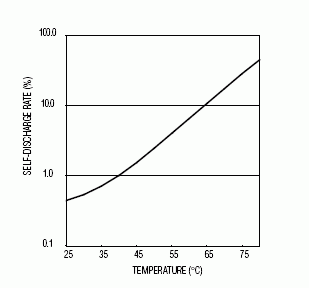
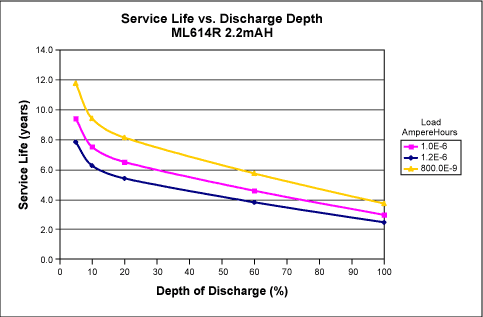
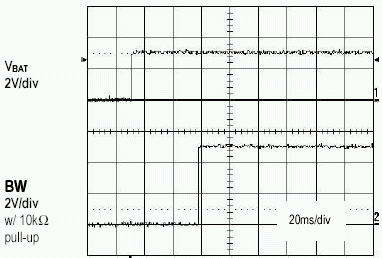
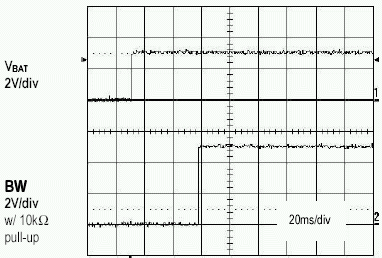
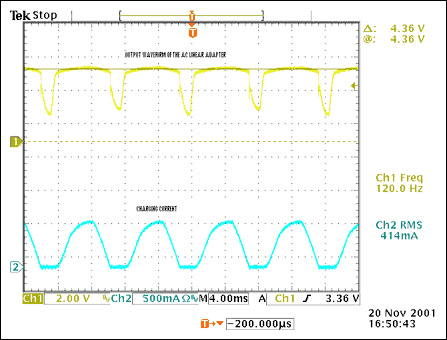
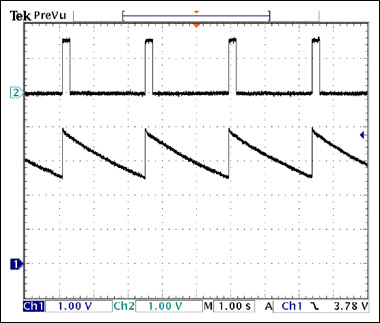
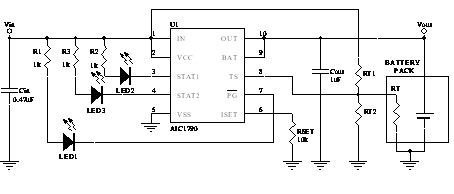













評論